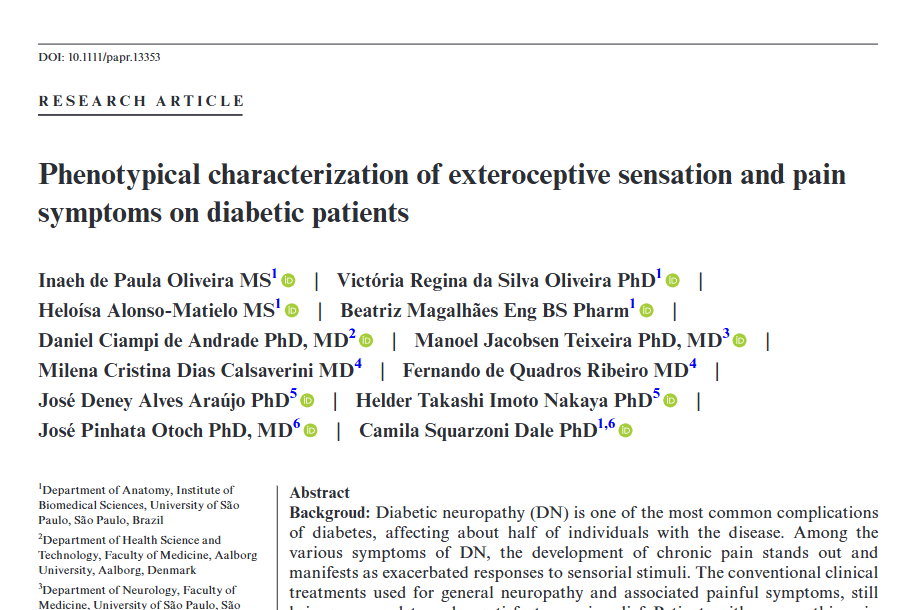Phenotypical characterization of exteroceptive sensation and pain symptoms on diabetic patients.
BACKGROUD: Diabetic neuropathy (DN) is one of the most common complications of diabetes, affecting about half of individuals with the disease. Among the various symptoms of DN, the development of chronic pain stands out and manifests as exacerbated responses to sensorial stimuli. The conventional clinical treatments used for general neuropathy and associated painful symptoms, still brings uncomplete and unsatisfactory pain relief. Patients with neuropathic pain syndromes are heterogeneous. They present with a variety of sensory symptoms and pain qualities which difficult the correct diagnosis of sensory comorbidities and consequently, the appropriate chronic pain management. AIMS: Herein, we aimed to demonstrate the existence of different sensory profiles on diabetic patients by investigating epidemiological and clinical data on the symptomatology of a group of patients with DN. METHODS: This is a longitudinal and observational study, with a sample of 57 volunteers diagnosed with diabetes from outpatient day clinic of Hospital Universitário of the University of São Paulo-Brazil. After being invited and signed the Informed Consent Form (ICF), patients were submitted to clinical evaluation and filled out pain and quality of life questionnaires. They also performed quantitative sensory test (QST) and underwent skin biopsy for correlation with cutaneous neuropathology. RESULTS: Data demonstrate that 70% of the studied sample presented some type of pain, manifesting in a neuropathic or nociceptive way, what has a negative impact on the life of patients with DM. We also demonstrated a positive association between pain and anxiety and depression, in addition to pain catastrophic thoughts. Three distinct profiles were identified in the sample, separated according to the symptoms of pain: (i) subjects without pain; (ii) with mild or moderate pain; (iii) subjects with severe pain. We also identified through skin biopsy that diabetic patients presented advanced sensory impairment, as a consequence of the degeneration of the myelinated and unmyelinated peripheral fibers. This study characterized the painful symptoms and exteroceptive sensation profile in these diabetic patients, associated to a considerable level of sensory degeneration, indicating, and reinforcing the importance of the long-term clinical monitoring of individuals diagnosed with DM, regarding their symptom profiles and exteroceptive sensitivity.
Authors
de Paula Oliveira I, da Silva Oliveira VR, Alonso-Matielo H
External link
Publication Year
Publication Journal
Associeted Project
Microbiology or Immunology
Lista de serviços
-
Genomic analyses reveal broad impact of miR-137 on genes associated with malignant transformation and neuronal differentiation in glioblastoma cells.Genomic analyses reveal broad impact of miR-137 on genes associated with malignant transformation and neuronal differentiation in glioblastoma cells.
-
RNA-Binding Protein Musashi1 Is a Central Regulator of Adhesion Pathways in Glioblastoma.RNA-Binding Protein Musashi1 Is a Central Regulator of Adhesion Pathways in Glioblastoma.
-
MicroRNA Transcriptome Profiling in Heart of Trypanosoma cruzi-Infected Mice: Parasitological and Cardiological Outcomes.MicroRNA Transcriptome Profiling in Heart of Trypanosoma cruzi-Infected Mice: Parasitological and Cardiological Outcomes.
-
Genome mapping and expression analyses of human intronic noncoding RNAs reveal tissue-specific patterns and enrichment in genes related to regulation of transcription.Genome mapping and expression analyses of human intronic noncoding RNAs reveal tissue-specific patterns and enrichment in genes related to regulation of transcription.
-
Antimicrobial peptide LL-37 participates in the transcriptional regulation of melanoma cells.Antimicrobial peptide LL-37 participates in the transcriptional regulation of melanoma cells.
-
Down-regulation of 14q32-encoded miRNAs and tumor suppressor role for miR-654-3p in papillary thyroid cancer.Down-regulation of 14q32-encoded miRNAs and tumor suppressor role for miR-654-3p in papillary thyroid cancer.
-
Integration of miRNA and gene expression profiles suggest a role for miRNAs in the pathobiological processes of acute Trypanosoma cruzi infection.Integration of miRNA and gene expression profiles suggest a role for miRNAs in the pathobiological processes of acute Trypanosoma cruzi infection.
-
Integrative Biology Approaches Applied to Human DiseasesIntegrative Biology Approaches Applied to Human Diseases
-
Proteomics reveals disturbances in the immune response and energy metabolism of monocytes from patients with septic shock.Proteomics reveals disturbances in the immune response and energy metabolism of monocytes from patients with septic shock.
-
Genomics, epigenomics and pharmacogenomics of Familial Hypercholesterolemia (FHBGEP): A study protocol.Genomics, epigenomics and pharmacogenomics of Familial Hypercholesterolemia (FHBGEP): A study protocol.
-
Melatonin-Index as a biomarker for predicting the distribution of presymptomatic and asymptomatic SARS-CoV-2 carriersMelatonin-Index as a biomarker for predicting the distribution of presymptomatic and asymptomatic SARS-CoV-2 carriers
-
Profiling plasma-extracellular vesicle proteins and microRNAs in diabetes onset in middle-aged male participants in the ELSA-Brasil study.Profiling plasma-extracellular vesicle proteins and microRNAs in diabetes onset in middle-aged male participants in the ELSA-Brasil study.
-
Big Data and machine learning in cancer theranosticsBig Data and machine learning in cancer theranostics
-
Genomic positional conservation identifies topological anchor point RNAs linked to developmental loci.Genomic positional conservation identifies topological anchor point RNAs linked to developmental loci.
-
Integrative systems immunology uncovers molecular networks of the cell cycle that stratify COVID-19 severityIntegrative systems immunology uncovers molecular networks of the cell cycle that stratify COVID-19 severity

